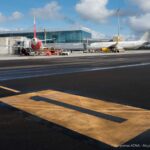American Airlines, Google Research, and Breakthrough Energy have joined hands to carry out a first-of-its-kind study on contrail avoidance. Using artificial intelligence, the study shows promising results in reducing contrail formation and thereby limiting aviation’s environmental impact.
Contrails are line-shaped clouds that form when aircraft fly through specific atmospheric conditions. Although seemingly innocuous, these cloud-like formations have significant implications for our environment, as they can trap heat within the Earth’s atmosphere or reflect sunlight back into space.
The Contrail Conundrum: An Environmental Challenge
The delicate balance of contrails’ environmental effects hinges on when they form. While reflecting sunlight during the day can cool the Earth, certain contrails trap heat at night, contributing to global warming. American Airlines, Google Research, and Breakthrough Energy embarked on an innovative study to address this complex issue.

Collaborative Approach: The Study in Detail
This pioneering study aimed to identify the atmospheric zones where contrails are likely to form and determine if pilots can avoid these areas in flight.
The research team leveraged large datasets, including satellite imagery, weather, and flight path information, to develop contrail forecast maps using artificial intelligence (AI). A group of American pilots then flew 70 flights over six months, modifying their routes according to the AI-based predictions to minimize contrail creation.
The results were astounding: the use of AI predictions led to a 54% reduction in contrail formation, as confirmed by satellite imagery.
Key Takeaways: A Proof of Concept
Juliet Rothenberg, the head of product for Climate AI at Google Research, stated that this study marks the «first proof point that commercial flights can use these predictions to avoid contrails.»
Though the results are promising, they stem from a limited number of test flights, indicating the need for more research to replicate and scale this success.
The partnership between American Airlines, Google Research, and Breakthrough Energy marks a significant step toward understanding a viable climate solution. By targeting contrail avoidance, the aviation industry is demonstrating its commitment to innovative, tangible change.
Marc Shapiro, Director of Breakthrough Energy Contrails, commends the collaboration, saying that «avoiding contrails might be one of the best ways to limit aviation’s climate impact, and now we have a clear demonstration that it’s possible to do so.»
The study’s success offers hope and a model for the industry, propelling the global fight against climate change.















FYI: all aircraft in flight produce contrails – whether you can see them visually or not.
The difference is the relative temperature / dew point spread at that altitude. If the dew point is cooler then the freezing point of water, the contrail is visible in the form of Ice crystals. If not, it is just the equivalent of steam which will be absorbed into the air.
Finally, most efficient jet airplanes produce two gases – water and carbon dioxide – both of which you consider greenhouse gases. If you want to live in the modern world of jet aviation then this is a cost of doing business. Otherwise, we had better ground all air transport and build sailing ships.